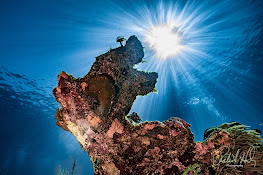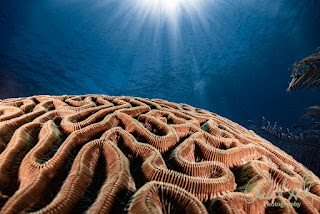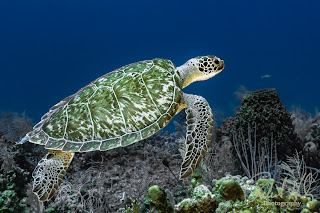Revolutionary Lighting Techniques in Underwater Photography
Introduction: Underwater photography is an exciting way to explore the depths and capture the beauty of marine life and aquatic terrains. However, taking pictures underwater poses unique challenges, particularly when it comes to lighting. Because of the properties of water and suspended particles, light behaves differently underwater, requiring advanced lighting techniques to produce visually stunning photographs. In this article, I will delve into several innovative lighting methods, discussing their effects on photography, the necessary equipment, and the optimal conditions for their use. I am sure there are other lighting techniques, but these are some of the ones I have experimented with.
Ambient Light Photography: Harnessing Natural Illumination
The Effect:
Underwater photography is a fascinating and rewarding hobby, but it can be challenging to capture the vibrant colors and intricate details of marine life. That's where strobe lighting comes in. Similar to a camera flash, underwater strobes emit a powerful burst of light that reveals the true colors of the underwater world, which are often lost in the shadows and hues of blue.
Implementation and Equipment:
To implement strobe lighting, you'll need some specialized equipment. The strobes themselves can be mounted directly on the camera or on separate arms for more flexible positioning. You'll also need fiber optic cables or electrical sync cords to trigger the strobes, and adjustable arms to direct the light precisely where you want it.
Ideal Use Cases:
Strobe lighting is ideal for a wide range of underwater photography applications. It's especially effective for capturing fast-moving subjects, such as schools of fish or sharks, where a fast shutter speed is crucial. It can also enhance the details of macro photography, revealing the intricate patterns and textures of small sea creatures. Additionally, strobe lighting can improve visibility in poorly lit environments, allowing you to capture stunning images even in the darkest corners of the ocean.
Drawbacks:
However, strobe lighting does have some drawbacks. In turbid waters or over greater distances, suspended particles can reflect the light, causing undesirable backscatter. This can reduce the effectiveness of strobe lighting and lead to less-than-ideal images. Nonetheless, with the right equipment, proper technique, and a bit of patience, strobe lighting can be a powerful tool for capturing stunning underwater photos.
Continuous Lighting: Visualizing the Scene
The Effect:
Continuous lighting is a type of lighting that provides a constant and steady light source for photographers. This type of lighting is particularly useful for those who want to pre-visualize the outcome of their shots, especially for video capture. It allows photographers to have a tangible sense of how light interacts with their subject, resulting in better control over the final image.
Implementation and Equipment:
To properly light up your underwater shots, you can either mount LED lights on the camera housing or use handheld units. It is important to choose lights that are specifically designed for underwater use, with a focus on waterproof ratings and luminescence. This ensures that your lighting equipment can withstand the harsh underwater environment and provide sufficient illumination for your shots.
Ideal Use Cases:
When it comes to diving in low-light conditions or exploring dark underwater caverns, having a reliable source of continuous lighting is crucial. Not only does it help you see clearly, but it also provides an added layer of safety. Additionally, continuous lighting can be a valuable tool for beginners, allowing them to better understand their surroundings and build their confidence in the water.
Drawbacks:
When it comes to choosing between strobe lights and continuous lights for photography or videography, it's important to consider a few factors. While strobes can offer vibrant coloration, continuous lights may not produce the same level of vibrancy. Additionally, continuous lights may require more battery power to operate for extended periods.
Ambient Light Photography: Harnessing Natural Illumination
The Effect:
When it comes to underwater photography, utilizing the available natural light can be an effective way to capture images with a serene and authentic feel. One technique that can help achieve this is to focus on the soft, diffused light that filters down from the surface. By doing so, you can capture the underwater world in its most natural state and create stunning images that are sure to impress.
Implementation and Equipment:
To ensure that you capture the perfect shot, it is important to adjust the camera settings to maximize the ambient light. This can be achieved by using a wide aperture, a slower shutter speed, and possibly a higher ISO setting. Additionally, a red filter can be used to counteract the blue tint of the water, resulting in a more vibrant and natural-looking image.
Ideal Use Cases:
If you are interested in ambient light photography, you may find it helpful to know that this type of photography usually produces the best results when you shoot in shallow waters with ample sunlight. Additionally, taking photos during the golden hours - the first and last hours of sunlight each day - can provide a naturally magical lighting effect that can enhance the overall quality of your photos.
Drawbacks:
It's worth noting that the effectiveness of this method may be limited in certain situations. For example, in deeper or murkier waters, or on overcast days, it may not be as effective as in clearer conditions. Additionally, capturing swift-moving subjects can also pose a challenge.
Snoot Lighting: Spotlighting the Subject
The Effect:
Snoot lighting is a technique that involves directing a highly concentrated light onto the subject while keeping the background dark. This method is commonly used in photography to create striking images that highlight the focal point of the shot, adding dramatic contrast and focus to the overall composition. By using snoot lighting, photographers can achieve a professional and polished look in their photos, making this technique a popular choice for portraits, product photography, and many other applications.
Implementation and Equipment:
When using a strobe or continuous light source, a snoot accessory can be used to narrow the light and achieve a specific effect. However, using a snoot requires careful alignment and positioning to achieve the desired precision.
Ideal Use Cases:
This technique is highly recommended for capturing macro shots or emphasizing particular aspects of a subject, thereby enhancing the artistic appeal of underwater photography.
Drawbacks:
When it comes to photography, it's important to select the appropriate lighting technique that would best suit the scene and subject. While snoot lighting can create an impressive effect and highlight the subject, it may not be the most suitable option when attempting to capture a wider scene or include the subject's surroundings. Achieving mastery of snoot lighting requires practice and patience, so it's important to keep experimenting and refining your skills.
Light Painting: Unleashing Creativity Underwater
The Effect:
Underwater photography offers a unique opportunity for creative expression through light painting. This technique involves moving a light source during a long exposure, allowing photographers to create stunning and otherworldly effects in their images. By 'painting' with light, photographers can infuse their shots with dynamic streaks or glowing halos that add a magical quality to their subjects. The possibilities for creativity with light painting in underwater photography are endless, making it a popular technique among photographers looking to push the boundaries of their craft.
Implementation and Equipment:
To create stunning light painting photographs, you will require a powerful and well-directed light source, like a dive torch, and a camera that can capture long exposures. The technique involves setting the camera's shutter speed to a slow pace and moving the light source in specific patterns or directing it toward specific parts of the subject or scene while the camera's shutter is open. With the right equipment and technique, you can produce mesmerizing light painting photos that will leave you and your audience in awe.
Ideal Use Cases:
Light painting is a photographic technique that works best for capturing still subjects, such as underwater wrecks or stationary marine life. This technique allows the photographer to have complete control over the movement of light, without worrying about the subject moving out of frame. By manipulating the light source, the photographer can create stunning and unique images that showcase the beauty and details of the subject.
Drawbacks:
To achieve the desired outcome in photography, one may need to use a technique that demands a steady hand and a clear vision. However, this technique can be tricky to master as it's easy to overexpose parts of the image or create unintended effects. Moreover, it can be more challenging to use this technique in areas with strong currents or where suspended particles might blur the light paths. Therefore, it's essential to practice and gain experience in using this technique to produce high-quality images.
High Dynamic Range (HDR) Imaging: Capturing Detail in
Shadows and Highlights
The Effect:
HDR imaging is a technique that involves capturing several photographs of the same scene at different exposure levels and then combining them into a single image. The resulting image has a much wider dynamic range than any of the individual photographs, making it possible to see details in both the darkest and brightest areas of the scene. This technique is especially beneficial when taking pictures underwater, where the contrast between light and shadow can be particularly challenging to capture accurately. By using HDR imaging, photographers can produce stunning images that showcase the full beauty of underwater landscapes and creatures.
Implementation and Equipment:
If you want to take high-quality HDR (High Dynamic Range) photos, you will need a camera that enables bracketed shooting. This means taking multiple photos of the same scene at different exposures. To create an HDR photo, you will also need software that can merge these images into one. The key is to capture a range of exposures from the same position, which means varying the shutter speed while keeping the aperture constant. This will ensure that you can capture all the details and color tones of a scene, from the darkest shadows to the brightest highlights, resulting in a stunning and realistic HDR photo.
Ideal Use Cases:
High Dynamic Range (HDR) imaging is a great technique to capture scenes with a wide range of light intensities. It is particularly useful when you want to capture details in both the highlights and the shadows of a scene. For instance, HDR imaging can help you capture the intricate details of a coral reef under direct sunlight or the sunbeams filtering into a cavern.
Drawbacks:
When capturing multiple shots to create an HDR image, it is important to keep in mind that any movement between the shots might result in ghosting effects in the final image. This makes the technique less suitable for dynamic scenes or fast-moving subjects. Moreover, HDR processing requires post-production work, which might not be preferred by photography purists who seek in-camera results.
Utilizing Color Filters: Correcting Color Balance
Underwater
The Effect:
As you know that the colors we see underwater are not the same as those on the surface? As we descend deeper, certain wavelengths of light get filtered out, causing a shift in color perception. This can make the underwater environment and its inhabitants appear dull and lifeless. However, there's a solution to this problem - underwater color filters. These filters are designed to compensate for the loss of specific wavelengths of light and restore the natural hues of the underwater world. By using color filters, we can capture the true beauty of the marine environment and its inhabitants in all their vibrant colors.
Implementation and Equipment:
When it comes to underwater photography, color filters play a crucial role in capturing vivid and vibrant images. These filters are placed over the camera lens or lighting source, and their selection is based on the diving depth and water conditions. For instance, red filters are commonly used in blue water to enhance warm tones, while magenta filters are preferred in green water to balance out the colors. By using the appropriate color filters, underwater photographers can achieve stunning and accurate images that truly represent the beauty of the aquatic world.
Ideal Use Cases:
Photographers and videographers often encounter challenges in capturing accurate colors and maintaining the natural color spectrum in their shots, especially while shooting in moderate depths of ambient light. In such scenarios, the use of filters can prove to be extremely helpful. Filters not only help in maintaining accurate color representation but also reduce the need for artificial lighting, making them an ideal choice for videographers who seek to capture natural-looking footage.
Drawbacks:
As a scuba diver, you might be using color filters to enhance the colors of the underwater world. However, it's important to keep in mind that the effectiveness of these filters varies depending on the depth and lighting conditions. In very low light conditions, the filters might not work at all, and artificial lighting may become necessary. Additionally, using the wrong filter can actually worsen the color imbalances, so it's essential to select the appropriate filter for the specific diving conditions.
Ultra-violet (UV) Lighting Techniques for Night Diving
The Effect:
Fluorescence photography, also known as UV lighting, enables us to witness the aquatic universe from a surreal and vibrant perspective. When exposed to UV light, some organisms and materials emit visible light through a process called fluorescence, which uncovers dazzling colors and patterns that are not visible under normal lighting conditions. This technique transforms the familiar underwater scenes into glowing and otherworldly landscapes, providing a unique and breathtaking experience.
Implementation and Equipment:
Underwater photographers often aim to capture the fascinating phenomenon of fluorescence. To achieve this, they use specialized equipment that includes UV or blue lights in combination with a camera that has a yellow barrier filter. This filter allows the camera to capture only the fluorescent light emitted by the subject, resulting in stunning images. The equipment setup typically includes a UV light source, a camera with manual settings, and a yellow filter that can be placed over the camera lens or dive mask.
Ideal Use Cases:
Underwater diving enthusiasts often use UV lighting techniques to observe marine life in a unique and mesmerizing way. Night dives are especially ideal for this method, as the absence of natural light enhances the visibility of fluorescent emissions. This technique is particularly useful for capturing vibrant photographs of coral reefs and certain species of fish that exhibit fluorescence, allowing us to explore and appreciate the hidden world of color that exists beneath the surface of the ocean.
Drawbacks:
When it comes to photographing fluorescent underwater scenes, one of the most important factors to consider is the lighting. Fluorescent photography is typically done under UV light, which requires complete darkness to achieve the full effect. As a result, this technique is usually limited to night dives or very dark environments. However, the unique lighting conditions and specialized equipment needed to capture these images can make focusing and composing shots a challenge. Additionally, photographers must be aware of their surroundings and navigate safely in the dark to avoid accidents and potential harm to marine life. Overall, while it can be a rewarding and captivating form of photography, fluorescent underwater photography requires patience, skill, and careful attention to detail.
Conclusion
Underwater photography is an art that requires a deep understanding of advanced lighting techniques. The right use of lighting can turn good shots into breathtaking ones. Underwater environments pose unique challenges, but by applying advanced lighting techniques such as strobe lighting and ultra-violet imaging, photographers can overcome these challenges. Each technique offers a different avenue for creativity and expression, enabling photographers to capture the beauty of the underwater world in all its diversity. By experimenting with different lighting approaches, photographers can highlight the vibrant colors of a coral reef or the haunting allure of a sunken ship. In short, mastering advanced lighting techniques in underwater photography is an ongoing journey that can lead to capturing the heart of the underwater world.
Stay tuned and "Follow" for upcoming blogs on underwater photography tips and tricks for more in-depth insights. Please leave your comments and suggestions. Enjoy your diving and shooting experience!
I am eagerly anticipating your valuable feedback and suggestions.
Sincerely,
Bob Herb
|
|





Comments
Post a Comment
Please let me know your comments.